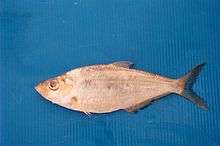Ilisha elongata
| Elongate ilisha | |
|---|---|
 | |
| Elongate ilisha on sale in a Chinese supermarket | |
| Scientific classification | |
| Kingdom: | Animalia |
| Phylum: | Chordata |
| Class: | Actinopterygii |
| Order: | Clupeiformes |
| Family: | Pristigasteridae |
| Genus: | Ilisha |
| Species: | I. elongata |
| Binomial name | |
| Ilisha elongata Bennett, 1830 | |
| Synonyms[1] | |
|
Pellona elongata Bennett, 1830 | |

Ilisha elongata, called the elongate ilisha (the FAO name) or Chinese herring or slender shad (even though it is not a close relative of herrings and shads) (Chinese: 勒鱼; pinyin: lèyú, or simply 鳓, lè), is a species of longfin herring native to the coastal waters and estuaries of North Indian Ocean and Northwest Pacific. It is a relatively large species, up to 45–60 centimetres (18–24 in) in total length. It is an important fishery species.[2][3]
Life history
In the northern part of its range, Ilisha elongata matures at age of 2 years and has a lifespan of about 6 years; in the warmer parts of its range, it matures under age 1 year and has a lifespan of about 3 years. It can spawn several batches of eggs.[4]
Fisheries and use
The species is commercially fished. Based on the FAO fishery statistics, the annual catches ranged between 80,400 and 98,700 tonnes in 2000-2009, all of them from the Northwest Pacific (FAO Fishing Area 61) and almost all of them caught by China.[5] The meat is tasty but has many bones.
References
- ↑ "Ilisha elongata". Integrated Taxonomic Information System. Retrieved 27 May 2012.
- ↑ Froese, Rainer and Pauly, Daniel, eds. (2011). "Ilisha elongata" in FishBase. November 2011 version.
- ↑ Whitehead, Peter J.P. (1985). FAO species catalogue. Vol. 7. Clupeoid fishes of the world. An annotated and illustrated catalogue of the herrings, sardines, pilchards, sprats, anchovies and wolfherrings. Part 1 - Chirocentridae, Clupeidae and Pristigasteridae (PDF). Rome: FAO. pp. 265–266. ISBN 92-5-102340-9.
- ↑ Zhang, J.; Takita, T.; Zhang, C. (2009). "Reproductive biology of Ilisha elongata (Teleostei: Pristigasteridae) in Ariake Sound, Japan: Implications for estuarine fish conservation in Asia". Estuarine, Coastal and Shelf Science. 81: 105–113. doi:10.1016/j.ecss.2008.10.013.
- ↑ FAO (Food and Agriculture Organization of the United Nations) (2011). Yearbook of fishery and aquaculture statistics 2009. Capture production (PDF). Rome: FAO. pp. 91–92.